Playing the Long Game
 Photographs are made in fractions of seconds, but a good photography project can take years—even decades. Just ask Harvey Stein. Like Aesop’s famous tortoise, Stein works slowly and persistently, often taking decades to cross the finish line. His study of Coney Island took over forty years; a project on Harlem has lasted for twenty-three. “With a long-term project, you can really dig into the work,” he says. “I feel I become an expert, and that makes me more confident.”
Photographs are made in fractions of seconds, but a good photography project can take years—even decades. Just ask Harvey Stein. Like Aesop’s famous tortoise, Stein works slowly and persistently, often taking decades to cross the finish line. His study of Coney Island took over forty years; a project on Harlem has lasted for twenty-three. “With a long-term project, you can really dig into the work,” he says. “I feel I become an expert, and that makes me more confident.”
Perhaps not coincidentally, many of Stein’s images have an old-fashioned aura. It’s sometimes hard to tell which of his images were made last year and which are from the 1970s. He’s an old-school street photographer, working mostly in black-and-white and gravitating toward urban grittiness and serendipitous gestures. “I’m sometimes accused of having old-fashioned work, but I don’t mind that,” he says. “I’m rooted in the documentary style: hopefully the work has power.”
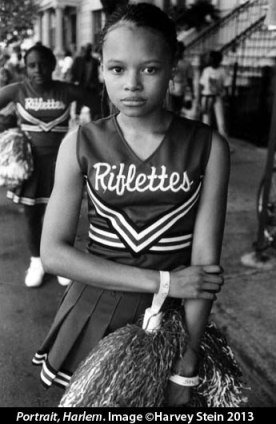 Last week, Stein and I walked through his new show at the Leica Gallery, ConeyIsland/Harlem: A Portrait of Two Communities (the show coincides with the publication of his new book, Harlem Street Portraits). I hadn’t seen him for eighteen years, since I took his Black & White Darkroom Three class at the International Center for Photography (digital cameras were barely around back then). He looked much the same: tall, with receding white hair and a gentle demeanor, like a kind, keenly observant uncle.
Last week, Stein and I walked through his new show at the Leica Gallery, ConeyIsland/Harlem: A Portrait of Two Communities (the show coincides with the publication of his new book, Harlem Street Portraits). I hadn’t seen him for eighteen years, since I took his Black & White Darkroom Three class at the International Center for Photography (digital cameras were barely around back then). He looked much the same: tall, with receding white hair and a gentle demeanor, like a kind, keenly observant uncle.
That manner—open and engaging, unthreatening—is what has allowed Stein to go into communities like Harlem and get in people’s faces, literally. He uses two Leica cameras fitted with wide-angle lenses, 21mm and 35mm, which forces him to get close for a portrait but also enables him to include some context in the background. Sneaking around to get images isn’t his style. “Some street photographers use telephoto lenses, but I want to be physically within three or four feet of my subjects,” he says. “I’d like them to be as aware of me as I am of them.”
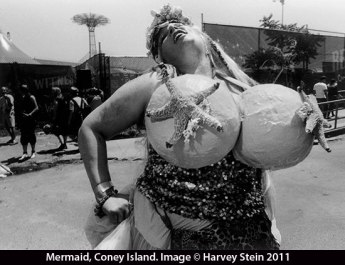 Take, for example, one of his best known images from Coney Island, of a voluptuous woman kitted out in an outrageous costume for the annual Mermaid Parade. Not only has Stein kept in touch with the subject, she attended the first show of his Coney Island images—dressed in costume, naturally. “She works in an office, but has this whole other side to her personality,” he says with a laugh.
Take, for example, one of his best known images from Coney Island, of a voluptuous woman kitted out in an outrageous costume for the annual Mermaid Parade. Not only has Stein kept in touch with the subject, she attended the first show of his Coney Island images—dressed in costume, naturally. “She works in an office, but has this whole other side to her personality,” he says with a laugh.
Another Coney Island image, which graces the cover of his book Coney Island: 40 Years, 1970-2010, shows a good-looking young couple caught in a spontaneous embrace, with two friends reaching toward them as the boardwalk glitters in the background. How did Stein manage to get so close at such a perfect moment? “I just happened to be there,” he says lightly, shrugging it off as if anyone would have the nerve to do this.
Walking through the Leica Gallery, I asked him if he’d ever gotten ribbed for being a white man taking photographs of Harlem. In the back of my mind was the Aaron Siskind-led Harlem Document, a 1930s project of the Photo League, which was criticized at the time for being shot by middle-class white men. “I’ve never been insulted or chased,” Stein avers. If someone asks him not to take a photo, he respects that, he says. He’s proud that at a book signing recently in Harlem, a black woman stood up and said, “I don’t see race in this book”—to him too, it’s a book about people, period. Capturing tensions between Harlem’s old guard and its new, white residents doesn’t interest him. Only one image in the book features anyone white, he points out—and then, only in the background.
A Pittsburgh native, Stein began his career in photography in 1970, after stints in the army and the corporate world (he has a degree in Metallurgical Engineering). When he started studying photography with teacher Ben Fernandez, it quickly took over. In fact, it was Fernandez who suggested that Stein “buy a Leica and a 21mm lens and go to Coney Island,” and one of Stein’s first images, of a dapper old man reading on the boardwalk, was published in the prestigious Life magazine. “I shoulda quit while I was ahead,” he chuckles.
Instead, he went on to establish his style, working in series and marrying serendipity to a careful, methodical approach. During a weekend of photographing in New York City one weekend in the early 1970s, he ran into three different sets of identical twins—a chance event that turned into a six-year project photographing identicals (well before Mary Ellen Mark did the same thing). Another early project, of artists in their surroundings, lasted from 1980 to 1985, featured portraits of such art stars as Keith Haring and Andy Warhol and was published as Artists Observed in 1986.
I can affirm that as a teacher, Stein is engaged and generous. In fact, it’s thanks to him you’re reading these words. At the end of his class eighteen years ago, when I told him I was about to get married, move to San Francisco and begin a career—hopefully in writing and photography—he told me to go see his friend Jo Leggett. Jo owned a photography magazine, Photo Metro, and it was there that I began to write and learn to appraise photography. The rest, as they say, is history.
Now, seeing Stein again, I think of how the world has changed in the eighteen years since we’ve seen each other. The digital revolution has happened, transforming the ways in which we interact and record our lives. Coney Island has gotten a facelift; Harlem is gentrifying, with graffitti and barred windows giving way to fancy restaurants, apartments and the pinnacle of bourgeois aspiration, Wholefoods (slated to open in 2015). Even life itself seems to have sped up, with barely any time for rest and reflection.
In the midst of this flurry, Stein is a reminder that not everything has to happen at warp speed. “I’ve always been a patient person,” he offers. For him, the culmination of every project is that embodiment of old media, a book, which puts his work out in the world in a tangible and permanent way. “I’m not looking to make money; I just want the book to be as good as possible,” he says. Old-fashioned words from one of photography’s old-fashioned gentlemen.
——————————————————–
Harlem/Coney Island: A Portrait of Two Communities is on show at the Leica Gallery through February 22, 2014. For hours and directions, click here.
Harvey Stein’s web site is here.
5 comments on “Playing the Long Game”
Leave a Reply
Connecting to %s

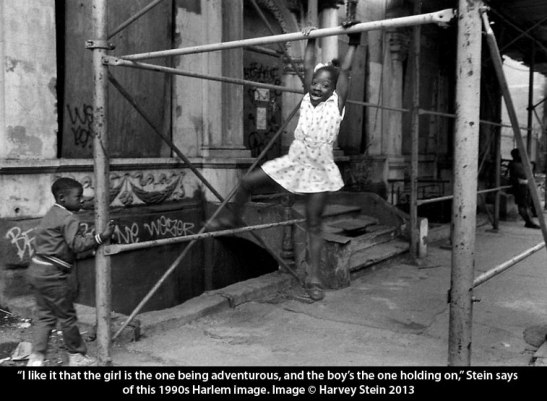
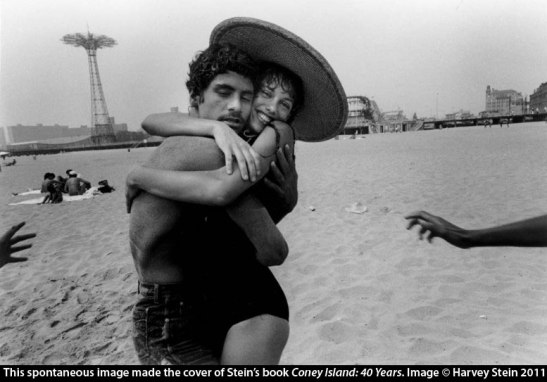
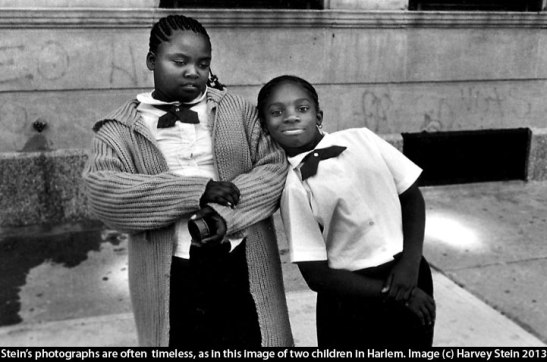
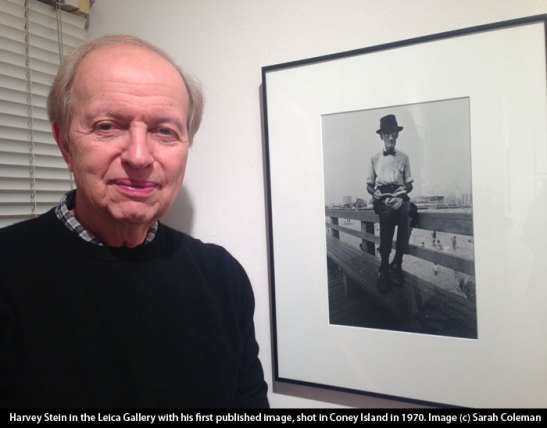
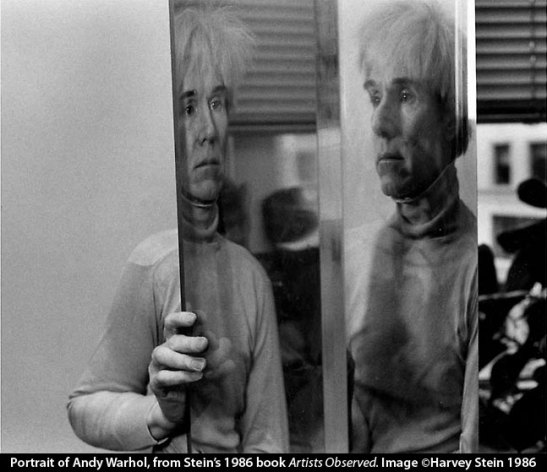
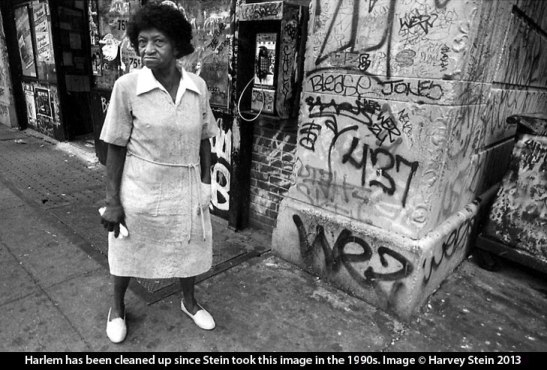

Sarah, what engaging photographs. It sounds like Stein’s respectful and soft approach allowed his subjects to feel comfortable enough to allow him access, something other portraiture artists lack. Obviously, his patience paid off in creating collections of absorbing yet gritty images. I hope to attend the Leica show if you’d like to join me.
Of course he’s “old school”. His work isn’t glib or superficial.
Brilliant article – interesting, informed and well written – all that we’ve come to expect from the Literate Lens! xxx Joanna
Hallo Sarah,
Harvey forwarded the link to this piece, you did justice to his work, both current and from the past.
My Mother loved you much.
Please email me, when you’re able, we can exchange contact information.
Much Love
Cate
Jo’s daughter
Lovely work and very well-written analysis- warm, generous and personal.